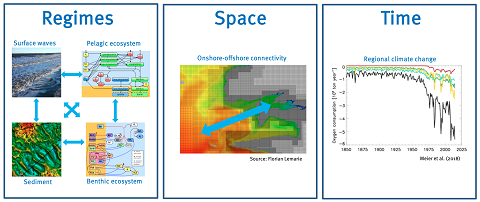

Workpackage 4 - Numerical Modelling
Essential transformation processes in shallow coastal waters are not resolved and transports into the Baltic Proper are not sufficiently reproduced in current state-of-the-art Baltic Sea models.
This is because these models are generally based on one-way nesting techniques which transmit boundary values from larger basin-scale models to local coastal models via several intermediate steps. Also between different regimes (e.g., waves, currents, sediment) often only a one-way coupling is applied. Therefore, based on the existing model infrastructure at IOW, we build a modular multi-scale model system for simulating the relevant physical and biogeochemical processes and interactions within the Baltic Sea. With this, the modelling WP4 contributes to all research questions and specific hypotheses of the STB research unit. Specifically, the functioning of marginal seas and climate change issues can only be investigated by means of a well-constructed and well-calibrated model system.
Central tasks of Work Package 4:
- Consistent coupling of waves, currents, turbulence and sediment dynamics in shallow water to reproduce shallow water effects of surface waves
- Establishment of a coupled pelagic-benthic biogeochemical model for shallow coastal waters to quantitatively reproduce the coastal filter
- Development of a flexible two-way nested model system to resolve feedbacks from coastal to basin scale processes
- Process-resolving scenario simulations
- Development of a near-real-time hindcast system with resolved coastal scales
- Extension of climate downscaling models towards resolving shallow water processes